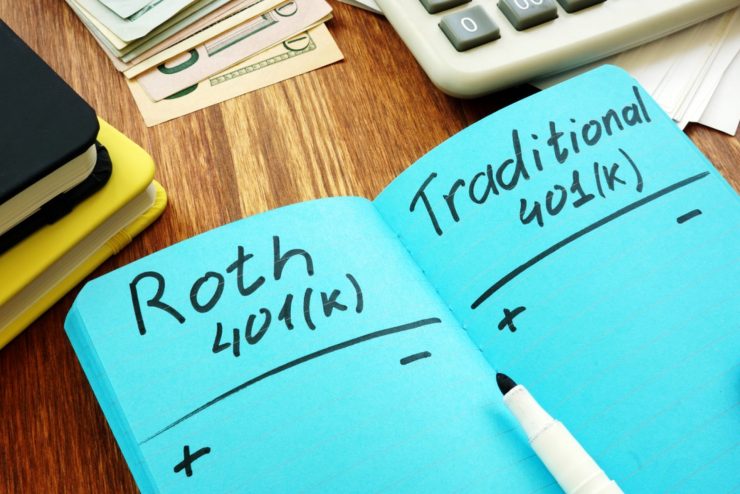Traditional 401K or Roth 401K: Is It Time You Reevaluated?
October 6, 2021
If your employer retirement plan gives you a choice to contribute to a traditional 401k plan or a Roth 401k plan, which do you choose?
While contributing to any retirement plan is a big step in the right direction, there may be significant advantages in choosing one type of plan over another—or participating in both. That choice mainly comes down to your current financial circumstances as well as your outlook for the future. Here are some key considerations when deciding between a traditional 401k plan and a Roth 401k plan.
Differences Between Traditional and Roth 401K
The key differences between a traditional and Roth 401k are (1) the tax treatment of contributions in the accumulation phase and (2) the tax treatment of withdrawals during the distribution phase. With a traditional 401k, your contributions are tax-deductible. If you contribute $5,000 to your plan, you reduce your taxable income for the year by $5,000. Accumulation inside the plan is tax-deferred, meaning you will ultimately pay taxes when you take withdrawals from the plan unless they are paid directly to a qualified charity after reaching age 70 ½.
With a Roth 401k, your contributions are made after-tax, meaning they do not reduce your taxable income in the year you save to the 401k plan. However, accumulation inside the plan and qualified withdrawals are tax-free.
Therefore, the crux of making this decision is rooted in comparing your current tax situation with what you project your tax situation will be in the decumulation phase of your life. Said in other words, the decision comes down to whether you want favorable tax treatment now through current tax savings or in retirement with tax-free income.
A Case for a Traditional 401K
Don is a 43-year-old single tax filer, with an adjusted gross income (AGI) of $250,000 a year. That puts him in the 32% marginal federal tax bracket plus state income taxes. Don believes he will be in a lower tax bracket in retirement, in particular, because he expects to relocate to a more tax-friendly state that either does not have income taxes or does not tax retirement plan withdrawals. Under those circumstances, Don will benefit more from a current 32% federal tax deduction plus any current state income tax savings by contributing to his Traditional 401k today.
A Case for a Roth 401K
Mary is a 29-year-old single tax filer, with an AGI of $40,000. She pays no state taxes, and his federal tax rate is 12%. She believes she will be paying taxes at a higher rate in retirement, so she could benefit more from tax-free withdrawals rather than a 12% tax deduction now.
The takeaway from these two examples is that high-income earners could benefit more from a current tax deduction provided through a traditional 401k, while lower-income earners could benefit more from future tax savings of the Roth 401k. If your circumstances change, such as finding yourself at some point in a lower or higher tax bracket, you should consider switching strategies.
The Case for Splitting Contributions
No one knows what future tax rates will be. We don’t know how the political winds will shift over time. However, you can make assumptions based on how much income you expect to receive in retirement. It’s generally assumed our income will be lower in retirement—though that’s not always true. If you’re not certain of your future outlook (who really is?), or if you don’t expect your tax rates to change much in the future, splitting your contributions between both a traditional and Roth 401k may provide the following benefits for those willing to think outside of the box.
- Saving assets to both account types would allow for the strategic use of risk bucketing. Assets within Roth accounts could be positioned more aggressively for longer-term tax-free growth whereas the traditional account could be invested less aggressively over time as you approach retirement. Assuming the more conservatively invested traditional account earns less, that would mean less taxes owed on withdrawals and you would get to keep more of your investment earnings.
- Roth plans are not subject to required minimum distribution (RMD) rules. For some retirees, being forced to withdraw from their tax-deferred accounts at age 72 isn’t an ideal situation, especially when they don’t need the income and it leads to a significantly larger tax bill. By contributing to the Roth 401k, tax-free growth can extend for your lifetime and up to an additional 10 years for a non-spouse beneficiary.
- Greater options for large one-time withdrawals in retirement to better manage your annual taxes. If your income sources are primarily from tax-deferred accounts, withdrawing assets could push you into a higher tax bracket. Not only could this lead to a higher tax bracket, which equates to paying more in taxes, but also potentially resulting in increased taxability of your Social Security benefits and/or increasing Medicare Part B and Part D monthly premiums
Consult a Professional
In addition to the decision of how to allocate among Traditional vs Roth, there are other saving vehicles that should be considered. For example, are you eligible to contribute and invest to a Health Savings Account or make backdoor Roth IRA contributions?
There is no “one-size-fits-all” solution in retirement planning, and it’s certainly not advisable to just set it and forget it. Circumstances change, and so does tax policy. Failing to understand your options and how to maximize your tax benefits can be very costly over the long term. With so much at stake, it’s best not to go it alone. Align with a team of financial advisors who can guide you through both your accumulation and retirement stages. When the winds of change do blow, you’ll have professionals in your corner ready to protect what you’ve built.


